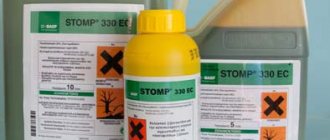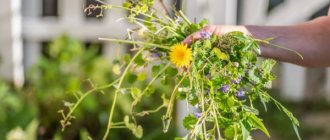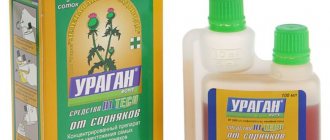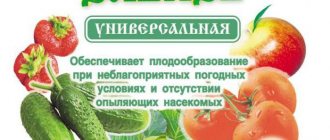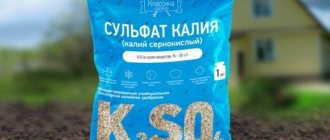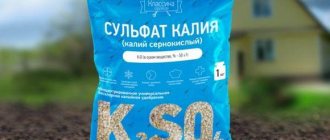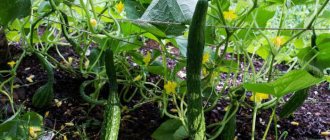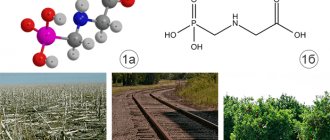To combat cereals, annuals, mono- and dicotyledonous weeds, some farmers use special chemicals. The use of the herbicide Stomp, which is known for its wide spectrum of action, is considered the most effective measure for eliminating weeds from the garden. To get the desired result, it is necessary to correctly calculate the dosage for each individual crop and the time of application.
Composition and release form of the herbicide Stomp
There are two types of the product:
- 33% emulsion concentrate (EC) 330 EC (contains 330 g/l pendimethalin). The tool is not currently in use because the license expired in 2022.
- 45.5% microencapsulated suspension Professional (455 g/l pendimethalin). More effective than CE, the license is valid until 2022 (possibly an extension).
All recommendations presented apply specifically to Professionals.
Advantages and disadvantages
The benefits of the herbicide include:
- It destroys weeds well in “weekend gardens” - relatively well-groomed but irregularly cultivated areas.
- Belongs to the third class of danger, harmless to people and bees.
- Fights against various types of weed annuals.
- A single treatment is sufficient.
- Almost completely decomposes in the soil; various types of crops can be planted on the treated area.
- Able to fight not only weeds, but also insect pests.
- Long-lasting, so weeding will no longer be necessary.
However, the drug Stomp also has disadvantages:
- It will not help if the area is new, very overgrown or has not been cultivated for a long time. It is powerless against the abundance of wheatgrass and quinoa.
- The best effect is achieved on light soils enriched with humus. Does not work on peat, gley, silty soils, floodplain meadows.
- Sensitive to weather conditions: precipitation will help destroy all weeds; without it, the effectiveness will be reduced.
See also
Instructions for use of Teldor fungicide, compatibility and analoguesRead
Purpose
Selective systemic herbicide for the control of dicotyledonous weeds in crops of grain, flax, potatoes, peas and other crops.
Advantages
- Approved for use on a large number of agricultural crops.
- Effective against the most common and harmful weeds: young dicotyledonous and perennial root shoots.
- Highly effective component of tank mixtures.
Preparative form
A water-soluble concentrate containing 590 g/l of a mixture of sodium, potassium and dimethylamine salts of MCPA acid (equivalent to 500 g/l of pure MCPA acid).
Mechanism of action
Systemic herbicide. Agritox® is absorbed by the leaves and affects the above-ground organs and root system of weeds. The drug suppresses the synthesis of growth substances and enzymes, inhibits the processes of photosynthesis and respiration.
Activity spectrum
Herbicide-sensitive weeds:
- hemlock stork (Erodium cicutarium);
- hemlock stork (Erodium cicutarium);
- hemlock stork (Erodium cicutarium);
- hemlock stork (Erodium cicutarium);
- hemlock stork (Erodium cicutarium);
- hemlock stork (Erodium cicutarium);
- hemlock stork (Erodium cicutarium);
- hemlock stork (Erodium cicutarium);
- hemlock stork (Erodium cicutarium);
- hemlock stork (Erodium cicutarium);
- hemlock stork (Erodium cicutarium);
- hemlock stork (Erodium cicutarium);
- hemlock stork (Erodium cicutarium);
- hemlock stork (Erodium cicutarium);
- hemlock stork (Erodium cicutarium);
- hemlock stork (Erodium cicutarium);
- hemlock stork (Erodium cicutarium);
- hemlock stork (Erodium cicutarium);
- hemlock stork (Erodium cicutarium);
- hemlock stork (Erodium cicutarium);
- hemlock stork (Erodium cicutarium);
- hemlock stork (Erodium cicutarium);
- hemlock stork (Erodium cicutarium);
- hemlock stork (Erodium cicutarium);
Slightly sensitive weeds:
- hemlock stork (Erodium cicutarium);
- hemlock stork (Erodium cicutarium);
- hemlock stork (Erodium cicutarium);
- hemlock stork (Erodium cicutarium);
- hemlock stork (Erodium cicutarium);
- hemlock stork (Erodium cicutarium);
- hemlock stork (Erodium cicutarium);
- hemlock stork (Erodium cicutarium);
Period of protective action
Agritox® provides effective protection of crops from treatment until a new wave of weeds appears.
Impact speed
The first symptoms of herbicidal action in the form of wilting, drying out and curling of susceptible weeds appear after 3–7 days, and death occurs 2–3 weeks after spraying Agritox®, depending on prevailing weather conditions. The fastest herbicidal effect is achieved when treating early stages of development of young dicotyledons and in the rosette phase of perennial root shoot weeds, as well as under favorable growth conditions - optimal humidity and temperature. In dry weather, the effect of the herbicide may worsen, since the penetration of the active substance into the plant slows down due to a general decrease in the outflow of assimilates from the leaves.
Phytotoxicity
Grain crops show high resistance to the drug in the recommended growth phases (from tillering to booting), the yield of which significantly increases with treatment. When used at maximum application rates for vegetative plants on some crops (flax, peas, potatoes), slight negative manifestations of the herbicide's action are possible in the first days after application. For example, on flax this can be expressed in a slight decrease in plant height and a slight deterioration in the quality of flax straw. In this regard, to reduce consumption rates, it is proposed to use Agritox® more widely in a mixture with other herbicides.
Possibility of resistance
There were no cases of weed resistance to the drug.
Compatibility
To expand the spectrum of action on dicotyledonous weeds, it is advisable to combine Agritox® with bromoxynil and sulfonylureas (Secateurs®, Secateurs® Turbo). It is also possible to mix it with insecticides, fungicides and fertilizers, provided that the application periods coincide. Before use, it is recommended to test the physical and chemical compatibility of the drugs being mixed.
Best before date
at least 2 years
Package
10 l
Application regulations
| Culture | Consumption rate of the drug, l/ha | Processing time | Waiting time (processing) |
| Wheat, barley, winter rye | 1–1,5 | During the tillering phase of the crop before it emerges into a tube (in spring) | 60 (1) |
| Wheat, barley, oats, spring | 0,7–1,5 | ||
| Millet | 0,7–1,2 | ||
| Peas for grain | 0,5–0,8 | 3–5 true leaves of the crop (for plant heights of 10–15 cm). Treatment is prohibited during the flowering period of the crop. | |
| Food potatoes | 1,2 | Spraying the soil before crop germination. Working fluid consumption – 200-300 l/ha |
How does the drug remove weeds?
The active ingredient is pendimethalin, the features of which are as follows:
- The next 14 days after treatment, the substance is distributed over the soil layer in which the weed seeds are located.
- When weeds germinate, active work begins; the drug penetrates into plant seedlings, preventing DNA synthesis.
- The cells lose their ability to divide, causing the seedling to die.
Important! If weed seedlings already exist, treatment with Stomp should be carried out until the development of two true leaves (for dicotyledons) or the first pair of leaves (for cereals).
Spectrum of protective action
The drug helps protect the following plants:
- carrot;
- tomatoes;
- onion;
- peas;
- potato;
- cabbage;
- beans;
- garlic;
- corn.
Effective in the fight against mono- and dicotyledonous weeds, especially annuals that do not form tubers or bulbs. This:
- Monocots: annual bluegrass, chicken millet, broom grass.
- Dicotyledons: woodlice, knotweed, chamomile, black nightshade, field violet, forget-me-not, speedwell.
The effect on biennials is less effective, but Stomp helps reduce the amount of field grass and shepherd's purse on the site.
Customer Reviews
I have a small plot of land near my house. I constantly grow carrots, beets, tomatoes, and herbs there. After all, your own is much better than store bought. But unfortunately, the soil on my site is very unkempt: it is simply sown with weeds. I use herbicides every season. But the earth is probably already accustomed to these means, and the weeds simply flourish, while the growth of my plantings is damaged. I realized that I needed to change the herbicide.
I heard that Stomp is one of the best drugs for weed control. Moreover, the product acts on all types of weeds. I sprayed the garden with this herbicide and got the desired result. The weed is gone, no new one appears, the vegetables grow normally. A good product, I will use it constantly now.
Maria, 36 years old
I have 45 acres of land (vegetable garden), and, naturally, the weeds simply attack me. I'm already tired of fighting them. Previously, I didn’t resort to herbicides, I pulled the weeds myself, but it was of little use, the harvest was almost ruined. I recently became acquainted with a drug called Stomp. If I had known how effective it was, I would have used it before. I don’t know what other good herbicides there are, but this one helped me.
I bought it in a regular store for farmers.
I read the instructions carefully, did not see any difficulties in using it, and began preparing the solution. It’s good that everything is written very clearly in the instructions and the dosages are indicated for a specific amount of water and hectare of land. I selected everything correctly, diluted the solution and sprayed the ground. The result was much better than I expected: there were no weeds, the harvest was a success. I would recommend this herbicide to everyone, as the quality and effectiveness of the product are simply amazing. Alexander, 45 years old
Consumption rates depending on the type of crops grown
The dosage of the drug depends on which crop will be processed. Information about the standards is presented in the table:
| Plant | Consumption, l/ha |
| Potato | 5 |
| Corn, carrots, tomatoes, cabbage, sunflower, garlic, soybeans | 3-6 |
| Onion, parsley | 2,5-4,5 |
The maximum dosage is used for poor clay soil, the minimum for light, nutritious soil.
Important! Herbicide treatment must be carried out a certain number of days before harvest:
- carrots, sunflowers – 50;
- garlic, cabbage – 40;
- tomatoes – 35;
- potatoes – 30 days;
- peas – 25.
How to use the drug correctly
The instructions for use state that Stomp should be used as follows:
- Spray the soil after the crop has been sown, but the seedlings have not yet appeared.
- For seedlings and cabbage - before transferring it to the soil.
- Carrots can be processed after germination.
- Aeronautical spraying is not permitted.
- Application into moist soil increases effectiveness, so if the soil is dry, it is recommended to water it before application.
See also
Instructions for the herbicide Zenkor and rules for using the productRead
The procedure should be carried out in calm weather, in the morning or evening.
Targets
The general features of the action of Stomp are also superimposed on the specific sensitivity of different plants to pendimethalin. As a result, on soils suitable for this preparation (see above), the use of the Stomp herbicide will certainly suppress the development of the following weeds:
- Veronica;
- Field forget-me-nots;
- bedstraw;
- Scilla annual;
- Chamomile officinalis.
In favorable climatic conditions (also see above), except for those indicated, manual weeding will not be required:
- Amaranths (amaranths, except foxtail);
- Veronica (species);
- Knotweeds rough and bindweed;
- Field mustard;
- Barnyard grass (species);
- Chickweed average;
- Common groundsel;
- Quinoa is garden and spreading;
- White pigweed;
- Common broom;
- woodlouse;
- Common bluegrass;
- Wild radish;
- Chamomile (unscented and other types);
- Sow thistle (species);
- Common pikulnik;
- Purslane;
- Mayweed;
- Chicken millet;
- Sorghum (species);
- Field toritsa;
- The bristles are green and gray;
- Field violet;
- Purple lily.
Finally, against the trail. weed herbicide Stomp will be quite effective only in wet years on light humus-rich soils:
- Galinsoga parviflora;
- Bird's knotweed;
- White mustard;
- Fumerica officinalis;
- Levcoyus jaundice;
- Ropeman of Theophrastus;
- Stinging nettle;
- Foxtail (foxtail amaranth);
- Canadian small petal;
- Dandelion;
- Nightshade black;
- Shepherd's Purse;
- Cleavers;
- Crabgrass (species);
- Field jar.
Safety precautions when working with the product
When working with Stomp, precautions should be taken. It is important to wear a scarf, protect your face with a cotton-gauze bandage or a respirator, your eyes with special glasses, and your hands with gloves. Before processing, you should wear long sleeves and a raincoat on top. Any footwear is acceptable, but experts recommend rubber boots.
If the drug comes into contact with the skin or eyes, rinse the area with running water. If you experience nausea, vomiting, or general deterioration in health, you should consult a medical specialist, as there is a risk of poisoning.
Harm class
Stomp is a moderately dangerous herbicide for protein organisms, as it belongs to toxicity class III of the four available. The agrochemical is also dangerous for cereal seedlings, so you should take into account the proximity of fields with millet or oats to a summer cottage. Stomp does not have a negative effect on root crops and other garden crops.
When working with agrochemicals, personal protective measures should be used. Chemicals enter the body in different ways - through inhalation of fumes, through the eyes and skin. The penetration of agrochemicals into the gastrointestinal tract is especially dangerous. Upon contact with unprotected skin, irritation or burns occur, the same applies to the penetration of a toxic substance into the respiratory tract.
Note! The warmer the weather, the more dangerous poisoning from agrochemicals is.
To protect your hands, you need to choose durable rubber gloves; cloth and medical ones are not suitable. It is advisable to work in rubberized clothing. If this is not available, trousers and a jacket made of thick fabric will do.
Any herbicide solution that gets on an open area of skin must be washed off with soap and then running water. To wash the mucous membranes of the eyes, it is recommended to use a 2% soda solution (a teaspoon of baking soda per faceted glass).
If the respiratory tract is affected, it is recommended to drink a cup of warm milk with soda, and put mustard plasters on your back. If the solution penetrates inside, it is necessary to induce vomiting in order to cleanse the digestive tract of toxins.
After completing the treatment of the area, work clothes are thoroughly washed in a solution of laundry soap, not powder. Glasses should be wiped with alcohol or manganese solution. Shoes are also first washed with soapy water and then rinsed with running water. It is important that no traces of the chemical remain on the surface.
Increasing the effectiveness of the drug
To improve the effectiveness of the herbicide, you should use the following recommendations:
- Carry out the treatment in moderately warm weather (10-20 °C), without precipitation. In hot weather, increase the dosage.
- The best time to work is morning or evening.
- Within 14 days after treatment, the beds should be well moistened, this will stimulate the germination of weeds and their death.
